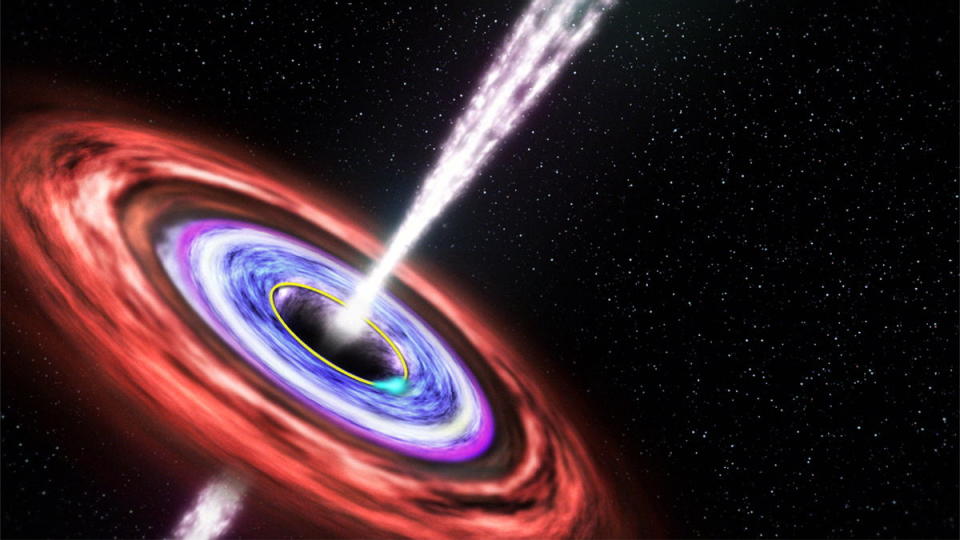Scientists may be one step closer to discovering how gamma-ray bursts became some of the most powerful explosions in the known universe.
For context, a single gamma-ray burst, or GRB, can produce more energy in seconds than the sun will radiate in billions of years. Because of this power, scientists suggest that GRBs are created by some of the most violent events in the universe. This includes things like supernova explosions, which signal the death of massive stars, and the collision and merger of two neutron stars, which are “dead” stars composed of the densest matter we know of, as well as explosions of baby black holes.
Still, some aspects of these bursts remain mysterious, including the mechanism that initiates a GRB and what exactly causes a “long” GRB that lasts more than 2 seconds versus a “short” GRB that lasts less time.
A team of scientists from the University of Alabama in Huntsville, for example, is studying the light bursts of GRBs and how they change over time to better model these bursts and eventually unravel their secrets.
Relating to: Giant gamma-ray flare from ‘recently deceased’ magnetar lights up Cigar Galaxy
“Despite being studied for over fifty years, the mechanisms by which GRBs produce light remain unknown; a major mystery for modern astrophysics,” team leader Jon Hakkila, a scientist at the University of Alabama in Huntsville, said in a statement. “Understanding GRBs helps us understand some of the fastest and most powerful light-producing mechanisms used by Nature.
“GRBs are so bright that they can be seen across the width of the universe, and because light travels at a finite speed, they allow us to see the earliest times when stars existed.”
Shedding light on GRBs
One of the main reasons why GRBs are so difficult to understand is that the theoretical models that describe them cannot explain the behavior of light curves, which are graphs that show how the light intensity of an object changes over time.
Further complicating the situation is the fact that no two GRB light curves are exactly the same, and the duration of bursts can last from mere milliseconds to tens of minutes.
Hakkila and colleagues modeled GRBs as a series of energetic pulses, reasoning that these pulses serve as the basic units of GRB emission. “These show times when a GRB brightens and then fades out. During the time a GRB pulse propagates, it undergoes changes in brightness that can sometimes occur on very short time scales,” Hakkila said. said. “The strange thing about these variations is that they are equally reversible. [palindrome] Words like ‘spinner’ or ‘boat’ can be reversed.”
The scientist added that it is very difficult to understand how this reversibility could happen because, unlike letters in a word, time can only be read in one direction.
“The mechanism that produces light in the GRB pulse somehow produces a pattern of brightness, then produces the same pattern in reverse order,” he said. “This is quite strange and makes GRBs unique.”

The team focused on GRB patterns produced when black holes (formed by the recent death of a massive star) explode jets of particles moving at near-light, or “relativistic,” speeds.
“In these models, the core of a dying massive star collapses to form a black hole, and material falling into the black hole is fragmented and directed outward along two opposing beams, or jets,” explains Hakkila. “The jet material heading in our direction is thrown outward at almost the speed of light.
“Since the GRB is relatively short-lived, it has been assumed that the jet remains pointed at us throughout the event. However, the time-reversed pulse characteristics have proven very difficult to explain whether they are due to a non-moving jet.”
To explain the palindrome-like nature of GRB light curves, the team added lateral, or sideways, motion to the relativistic jets moving away from the daughter black holes.
Hakkıla continued: “The idea of a sideways moving jet offers a simple solution by which the time-reversal GRB pulse structure can be explained.” “When the jet crosses the line of sight, the observer will first see the light produced by one side of the jet, then the center of the jet, and finally the other side of the jet.
“As the center of the jet crosses the line of sight, the jet will brighten and then dim, and the radially symmetric structure around the core of the jet will be seen in reverse order as the jet dims.”
Related Stories:
– 300 gamma-ray-bursting neutron stars found in a huge mass – and some of them are “spider pulsars”
— Pulsar surprises astronomers with record-breaking gamma rays
— The elusive origins of long gamma-ray bursts may finally be revealed
“In this ballistic model of GRBs,” relativistic jets from black holes spray material in a way similar to a fire hose spraying water, Hakkila added. Because the jets move like a fluid rather than a solid, an observer would see the entire jet as curved rather than straight, he said.
“The movement of the nozzle causes light from different parts of the jet to reach us at different times, and this can be used to better understand the mechanism by which the jet produces light, and also as a laboratory to study the effects of special relativity,” he concluded.
The team’s research was published April 22 in The Astrophysical Journal.